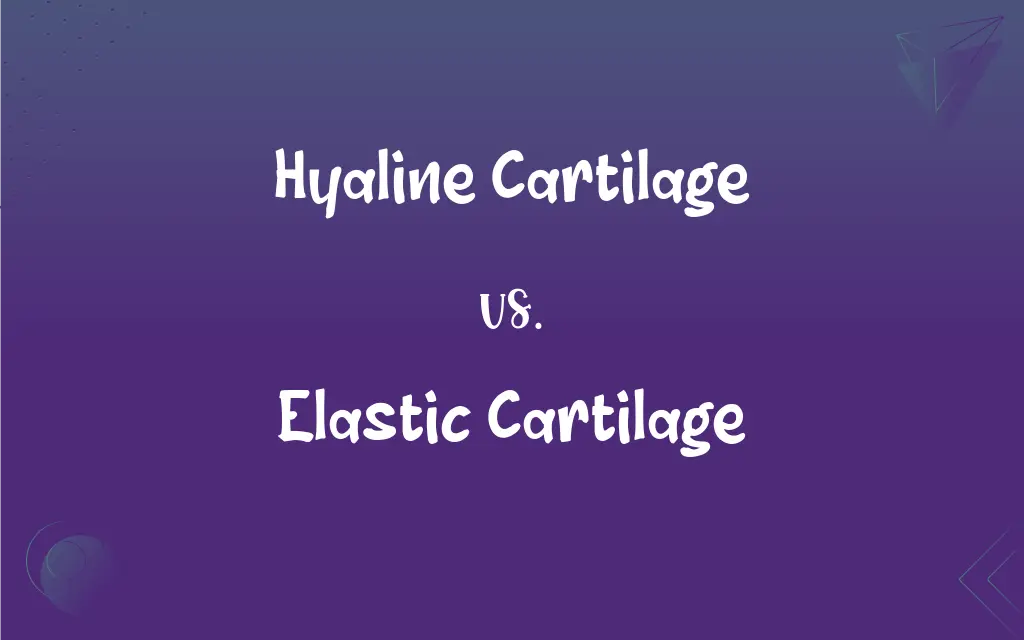Hyaline Cartilage vs. Elastic Cartilage: What's the Difference?
Edited by Aimie Carlson || By Harlon Moss || Published on December 31, 2023
Hyaline cartilage is smooth, glass-like, and found in joints and respiratory structures; elastic cartilage is more flexible, with abundant elastic fibers, common in the ear and epiglottis.

Key Differences
Hyaline cartilage, characterized by its translucent, glassy appearance, is the most common type of cartilage in the body, found in the nose, trachea, and at the ends of long bones. Elastic cartilage, distinguished by its elasticity and resilience, is primarily located in structures that require flexibility, such as the ear, epiglottis, and larynx.
In terms of composition, hyaline cartilage consists primarily of a dense network of collagen fibers, providing support and cushioning at joints. Elastic cartilage, on the other hand, has a similar matrix but is enriched with elastic fibers, allowing it to withstand repeated bending and returning to its original shape.
Hyaline cartilage plays a crucial role in the growth of long bones and forms most of the embryonic skeleton before being replaced by bone. Elastic cartilage does not ossify and remains flexible throughout life, playing a key role in maintaining the shape and structure of flexible body parts.
From a histological perspective, hyaline cartilage has a homogeneous matrix with chondrocytes in lacunae, while elastic cartilage exhibits a more fibrous matrix with visibly darker elastic fibers interwoven with chondrocytes.
In terms of clinical significance, damage to hyaline cartilage, as seen in osteoarthritis, can lead to joint pain and dysfunction. In contrast, damage to elastic cartilage, though less common, can affect the function of the ears and airways.
ADVERTISEMENT
Comparison Chart
Location in the Body
Joints, rib ends, nose, trachea, larynx
Ear, epiglottis, larynx
Composition
Collagen fibers, few elastic fibers
Many elastic fibers, some collagen
Function
Support, ease joint movement
Provide flexibility, maintain shape
Appearance
Translucent, glassy
Yellowish, opaque
Response to Damage
Prone to wear and tear, less regenerative
Better resilience, more regenerative
ADVERTISEMENT
Hyaline Cartilage and Elastic Cartilage Definitions
Hyaline Cartilage
It appears as a translucent, glass-like tissue in the joints and respiratory structures.
The hyaline cartilage of the trachea keeps the airway open for breathing.
Elastic Cartilage
It contains a high number of elastic fibers, giving it superior elasticity.
The flexibility of the epiglottis is due to the elastic cartilage composition.
Hyaline Cartilage
This type of cartilage provides smooth surfaces for the movement of joints.
Hyaline cartilage covers the ends of bones in the shoulder, facilitating smooth movement.
Elastic Cartilage
It is more opaque than hyaline cartilage and can withstand repeated bending.
Elastic cartilage in the larynx helps it to withstand the pressures of speech.
Hyaline Cartilage
Hyaline cartilage forms the embryonic skeleton before being replaced by bone.
The fetal skeleton is primarily composed of hyaline cartilage, which later ossifies.
Elastic Cartilage
This cartilage is found in areas requiring shape retention and flexibility.
Elastic cartilage is key in maintaining the structure of the external ear.
Hyaline Cartilage
Hyaline cartilage is a tough, yet flexible, connective tissue found in various parts of the body.
The hyaline cartilage in the knee joint absorbs shock during running.
Elastic Cartilage
Elastic cartilage does not calcify or harden with age, maintaining flexibility throughout life.
Even in older individuals, the elastic cartilage in the ear remains supple.
Hyaline Cartilage
It is essential for the growth and development of long bones.
In children, hyaline cartilage at the growth plates aids in the lengthening of bones.
Elastic Cartilage
Elastic cartilage is a type of connective tissue that is highly flexible and resilient.
The elastic cartilage in the ear allows it to bend and return to shape.
FAQs
What is hyaline cartilage?
It's a tough, flexible tissue found in joints and respiratory structures.
What diseases affect hyaline cartilage?
Conditions like osteoarthritis can deteriorate hyaline cartilage.
What is the main function of hyaline cartilage in joints?
It provides a smooth surface for joint movement and absorbs shock.
How does hyaline cartilage contribute to bone growth?
It forms the embryonic skeleton and facilitates the growth of long bones.
Is elastic cartilage more resilient than hyaline cartilage?
Yes, due to its elastic fibers, it's more resilient and flexible.
Is hyaline cartilage present in the spine?
Yes, it's found at the ends of vertebrae.
Where is elastic cartilage located?
In flexible body parts like the ear, epiglottis, and larynx.
What role does elastic cartilage play in the respiratory system?
It maintains the shape and flexibility of the epiglottis and larynx.
What makes elastic cartilage unique?
Its high content of elastic fibers, providing exceptional flexibility.
Can hyaline cartilage regenerate?
It has limited regenerative capacity, making damage often permanent.
What are the primary cells in hyaline cartilage?
Chondrocytes, which produce and maintain the cartilaginous matrix.
How does age affect elastic cartilage?
Unlike hyaline cartilage, it maintains its flexibility with age.
What happens to elastic cartilage in diseases like relapsing polychondritis?
It becomes inflamed and can deteriorate, affecting shape and function.
Can hyaline cartilage be replaced or repaired surgically?
Yes, though with limited success due to its complex structure.
How does elastic cartilage contribute to hearing?
It maintains the shape of the ear, essential for sound direction.
Can hyaline cartilage be seen through X-rays?
Not clearly, as it's less dense than bone.
How does injury to elastic cartilage manifest?
It can lead to deformities in flexible structures like the ear.
Is hyaline cartilage involved in joint diseases?
Yes, it's often implicated in degenerative joint diseases.
Does elastic cartilage undergo calcification?
Rarely, it generally remains flexible throughout life.
How is elastic cartilage different from other cartilages?
Its high elasticity and resilience set it apart.
About Author
Written by
Harlon MossHarlon is a seasoned quality moderator and accomplished content writer for Difference Wiki. An alumnus of the prestigious University of California, he earned his degree in Computer Science. Leveraging his academic background, Harlon brings a meticulous and informed perspective to his work, ensuring content accuracy and excellence.
Edited by
Aimie CarlsonAimie Carlson, holding a master's degree in English literature, is a fervent English language enthusiast. She lends her writing talents to Difference Wiki, a prominent website that specializes in comparisons, offering readers insightful analyses that both captivate and inform.






































































